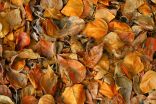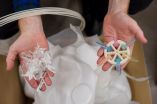(Press-News.org) New insights into botulinum neurotoxins and their interactions with cells are moving scientists ever closer to safer forms of Botox and a better understanding of the dangerous disease known as botulism. By comparing all known structures of botulinum neurotoxins, researchers writing in the Cell Press journal Trends in Biochemical Sciences on October 1st suggest new ways to improve the safety and efficacy of Botox injections.
"If we know from high-resolution structures how botulinum neurotoxins interact with their receptors, we can design inhibitors or specific antibodies directed at the binding interface to prevent the interaction," said Richard Kammerer of the Paul Scherrer Insititute in Switzerland. "Furthermore, it may be possible to engineer safer toxins for medical and cosmetic applications."
In addition to its popular cosmetic use, the neurotoxin is used for the treatment of muscle conditions related to cerebral palsy, multiple sclerosis, stroke, Parkinson's disease, and more.
The bacterium known as Clostridium botulinum, classically found as a contaminant in home-canned food, produces the neurotoxins, which pass the intestine and enter the bloodstream when ingested, Kammerer explained. When the neurotoxins reach neurons, they bind to receptors at the cell surface. Through a series of events, a portion of the toxin is released inside the cell. Once inside, that light-chain portion acts as a protease to specifically cleave a protein important for the release of acetylcholine, a neurotransmitter important for signaling from nerve to muscle. The result is paralysis, which can be fatal if the muscles required for breathing are affected.
Kammerer and his colleagues offer a comprehensive review of high-resolution structures of botulinum neurotoxins and their complexes with cell-surface receptors, many of which have become available only recently. While many questions remain, the new picture of BoNT/A and its interactions offers considerable hope for less-risky clinical use of Botox in the future.
"The wide range of BoNT/A dosage used in medical or cosmetic applications bears the substantial risk of accidental BoNT/A overdosage," the researchers write. "The BoNT/A-SV2C complex crystal structure provides a strong platform for the rational design of BoNT/A variants with attenuated SV2C binding properties. Such variants are promising candidate proteins for safer applications of the toxin."
INFORMATION:
Trends in Biochemical Sciences, Kammerer et al.: "Botulinum neurotoxins: new questions arising from structural biology."
Scientists aim to give botox a safer facelift
2014-10-01
ELSE PRESS RELEASES FROM THIS DATE:
Journal supplement examines innovative strategies for healthy aging
2014-10-01
WASHINGTON— The Society for Public Health Education (SOPHE) proudly announces the publication of a Health Education & Behavior (HE&B) supplement devoted to the latest research and practice to promote healthy aging. The October 2014 supplement, "Fostering Engagement and Independence: Opportunities and Challenges for an Aging Society," contains a dozen peer-reviewed articles on innovative behavioral and psycho-social approaches to improve the health of the nation's fastest growing cohort - older adults.
Together the articles describe promising advances in research directed ...
Hide and seek: Sterile neutrinos remain elusive
2014-10-01
BEIJING; BERKELEY, CA; and UPTON, NY - The Daya Bay Collaboration, an international group of scientists studying the subtle transformations of subatomic particles called neutrinos, is publishing its first results on the search for a so-called sterile neutrino, a possible new type of neutrino beyond the three known neutrino "flavors," or types. The existence of this elusive particle, if proven, would have a profound impact on our understanding of the universe, and could impact the design of future neutrino experiments. The new results, appearing in the journal Physical Review ...
New approach can predict impact of climate change on species that can't get out of the way
2014-10-01
CUMBERLAND, MD (October 1, 2014)--When scientists talk about the consequences of climate change, it can mean more than how we human beings will be impacted by higher temperatures, rising seas and serious storms. Plants and trees are also feeling the change, but they can't move out of the way. Researchers at the University of Maryland Center for Environmental Science and University of Vermont have developed a new tool to overcome a major challenge of predicting how organisms may respond to climate change.
"When climate changes, organisms have three choices: migrate, adapt, ...
Treatment of substance abuse can lessen risk of future violence in mentally ill
2014-10-01
BUFFALO, N.Y. — If a person is dually diagnosed with a severe mental illness and a substance abuse problem, are improvements in their mental health or in their substance abuse most likely to reduce the risk of future violence?
Although some may believe that improving symptoms of mental illness is more likely to lessen the risk for future episodes of violence, a new study from the University at Buffalo Research Institute on Addictions (RIA) suggests that reducing substance abuse has a greater influence in reducing violent acts by patients with severe mental illness. ...
A new target for controlling inflammation? Long non-coding RNAs fine-tune the immune system
2014-10-01
New Rochelle, NY, October 1, 2014—Regulation of the human immune system's response to infection involves an elaborate network of complex signaling pathways that turn on and off multiple genes. The emerging importance of long noncoding RNAs and their ability to promote, fine-tune, and restrain the body's inflammatory response by regulating gene expression is described in a Review article in Journal of Interferon & Cytokine Research (JICR), a peer-reviewed publication from Mary Ann Liebert, Inc., publishers. The article is available free on the JICR website.
In the Review ...
Intervention helps decrease 'mean girl' behaviors, MU researchers find
2014-10-01
COLUMBIA, Mo. – Relational aggression, or "mean girl" bullying, is a popular subject in news and entertainment media. This nonphysical form of aggression generally used among adolescent girls includes gossiping, rumor spreading, exclusion and rejection. As media coverage has illustrated, relational aggression can lead to tragic and sometimes fatal outcomes. Despite these alarming concerns, little has been done to prevent and eliminate these negative behaviors. Now, University of Missouri researchers have developed and tested an intervention that effectively decreases relational ...
CEC releases its first-ever multi-year examination of reported industrial pollution in North America
2014-10-01
This news release is available in French and Spanish. The Commission for Environmental Cooperation (CEC) has released a comprehensive report on the changing face of industrial pollution in North America, covering the years 2005 through 2010. This is the first time an edition of the CEC's Taking Stock series, which gathers data from pollutant release and transfer registers (PRTRs) in Canada, Mexico and the United States, has analyzed North American pollutant information over an extended timeframe. To view the report, visit http://www.cec.org/library.
This volume ...
New absorber will lead to better biosensors
2014-10-01
Biological sensors, or biosensors, are like technological canaries in the coalmine. By converting a biological response into an optical or electrical signal, they can alert us to dangers in our external and internal environments. They can sense toxic chemicals and particles in the air and enzymes, molecules, and antibodies in the body that could indicate diabetes, cancer, and other diseases.
An optical biosensor works by absorbing a specific bandwidth of light and shifting the spectrum when it senses minor changes in the environment. The narrower the band of absorbed ...
Ethical filament: Can fair trade plastic save people and the planet?
2014-10-01
It's old news that open-source 3D printing has a lot going for it: it's cheap, green and incredibly useful for making everything from lab equipment to chess pieces. Now it's time to add another star to the 3D printing constellation. It may help lift some of the world's most destitute people from poverty while cleaning up a major blight on the earth and its oceans: plastic trash.
At the center of the movement is a new set of standards inspired by fair trade products ranging from diamonds to chocolate.
"We are creating a new class of material called ethical 3D printing ...
New article shows daily use of certain supplements can decrease health-care expenditures
2014-10-01
Washington, D.C., October 1, 2014—Use of specific dietary supplements can have a positive effect on health care costs through avoided hospitalizations related to Coronary Heart Disease (CHD), according to a new article published in the Journal of Dietary Supplements(1). The article, "From Science to Finance—A Tool for Deriving Economic Implications from the Results of Dietary Supplement Clinical Studies," published by Christopher Shanahan and Robert de Lorimier, Ph.D., explores a potential cost-benefit analysis tool that, when applied to a high-risk population (U.S. adults ...



